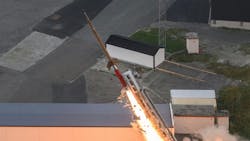DLR's ATHEAt flight experiment reusable space transport tech
ANDOYA, Norway - In the future, an increasing number of components in space transportation systems are set to be reusable – that is, they can used several times, making them more cost effective. As such, the German Aerospace Center (Deutsches Zentrum für Luft- und Raumfahrt; DLR) is developing the necessary reusability technologies and testing them using sounding rockets. On 6 October 2025 at 10:45 local time, the ATHEAt flight experiment successfully took off from its launch site on the island of Andøya in northern Norway. Over the sea, the experiment flew for a total of approximately four minutes, including two minutes of high-speed flight with the peak speed exceeding Mach 9. This range is particularly interesting: at such high speeds, the vehicle experiences gas temperatures exceeding 2000 degrees Celsius and extreme aerothermal loads act on its materials and structures – similar to those encountered by spacecraft re-entering Earth's atmosphere. During the flight the research rocket reached a maximum altitude of more than 30 kilometres. Comprehensive measurement data was successfully transmitted to the DLR and Andøya Space ground stations, the German Aerospace Center (DLR) reports. Continue reading original article.
The Military & Aerospace Electronics take:
8 October 2025 - "With the ATHEAt flight experiment, we have succeeded in flying at high Mach numbers for much longer than in our previous projects," summarizes Ali Gülhan, ATHEAt project manager and head of the Supersonic and Hypersonic Technologies Department at the DLR Institute of Aerodynamics and Flow Technology. "We have now reached a new milestone and collected unique data for further research and development." This data harvest was made possible by the more than 300 sensors installed by the DLR team into the flight experiment. Also on board were miniaturized, non-contact sensors such as infrared cameras, laser scanners and radiation thermometers. A modular data acquisition system developed by DLR recorded the measurements and transmitted the processed data by radio to ground stations below.
Related: DLR study outlines technology paths to cut aviation CO2 by 2070
Related: German Aerospace Center (DLR) laser clock achieves world-class accuracy
Related: Germany's DLR announces expanded low-carbon flying strategy
Jamie Whitney, Senior Editor
Military + Aerospace Electronics
